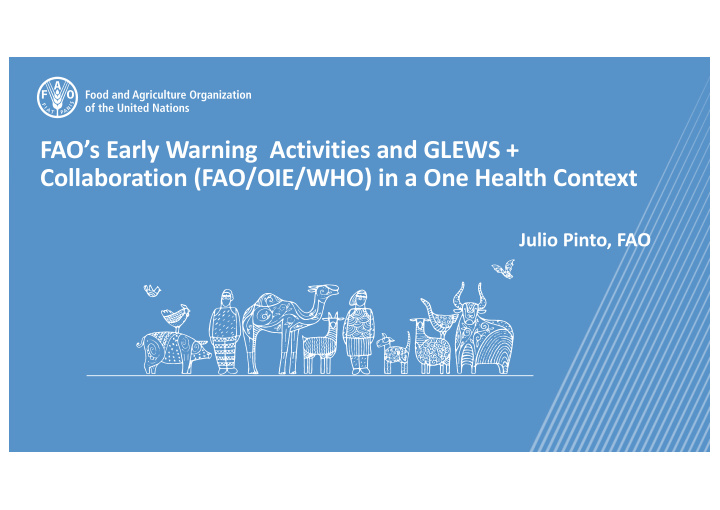



FAO’s Early Warning Activities and GLEWS + Collaboration (FAO/OIE/WHO) in a One Health Context Julio Pinto, FAO
FAO’s Animal Health Service Prevent, contain and control the world’s most serious animal diseases at their Protecting animals against diseases and source, while also surveying for newly preventing their transmission and spread is emerging zoonotic pathogens in a one of the keys to fighting hunger, malnutrition and poverty changing environment Core activities : Early warning and early detection to enhance early action and response.
increasing source of outbreak-related information verification early and effective response
Early Warning and Response Source: Changing Disease Landscape (World of Livestock 2013; FAO)
Disease Intelligence and Early Warning • ������A������� ��������.���. • �����/����/����� ����.��,�����,�����.�.���.�������.���.���� �.�-�,��������� • �������������/���������� ������������������,,�����.�� -�.�����.�����.�,������.����������������������������.� • +��������������� �������������������������.���.��.�� ��������������.�� • ����������� �����������/�������� �.�� ������������������/� • ��� ��� �������������������� � �.������������������� ��--�.�������-�.������.�����.�����������������
Di Disease Intelligenc nce and nd Early y Warni ning ng MONITORING PROCESS Verification Assessment Analysis Dissemination Detection - Scanning, screening and Data Analysts FAO HQ and Field FAO experts opinion Real-time Alerts monitoring: (EMPRES-i) FAO Reference Monitoring Weekly Updates FAO Decentralized Offices FAO Experts Centers Forecasting Monthly Updates International Organization GLEWS Platform Quarterly Updates National Authorities Web sources
TOP 15 DISEASES MONITORED (2014-2019) *AS OF 31 MARCH 2019 200 150 2014 2015 100 2016 2017 50 2018 0 H5… ASF Ebola FMD H7 LP/HP Mers-CoV PPR RVF Und. dis. Anthrax CSF H9 LP LSD NDV SGP Source: FAO GLEWS, Animal al Heal alth Threat Update (AHTU)
Early Warning and Forecasting • Real-time alerts (RVF, ASF, HPAI, FMD) • Rapid Risk Assessment Guidelines • Animal Diseases Updates ( Animal Health Threat Update, MERS-CoV, AI, ASF…) • Quarterly Early Warning Updates for Food Security (Food Chain Crisis Early Warning Bulletin, Early Warning Early Action Bulletin)
FAO Rapid Risk Assessments
Ea Early Warning systems • Global Animal Disease Information System – EMPRES-i • Global RVF monitoring/early warning system • National electronic reporting app – EMA-i
EM EMA-i implementation in 11 countri ries in Afri rica
GL GLEWS + • GLEWS was established in 2006 and has since evolved to GLEWS+ in 2013 • Initial funding from CIDA/Canada and France • GLEWS platform hosted in FAO since 2009 • Focal points from three partners • Disease tracking, verification and risk assessment, EW • The Joint FAO–OIE–WHO Global Early Warning System for health threats and emerging risks at the human–animal–ecosystems interface
FA FAO/WHO/OIE Global Early Warning System (GLEWS+) GLEWS+ Task Force Meeting, WHO HQ, April 2019
FA/OIE/WHO Common Vision: To improve global disease prevention, detection, early warning and response from biological threats (GHSA, G7 EIOS) Strengthen and modernise currently WHO, OIE and FAO systems Bring Info systems together (data sharing analysis) Link with capacity development activities in countries
WHO/EIOS Rumours Support the identification of alerts Formal sources Deduplication of efforts Inclusion of animal diseases (also non-zoonotic) Use EIOS as a means of communication
• Pillar 1: Sharing information to improve awarness of current and emergig health events based on respective information and intelligence networks • Pillar 2: Development and implementation of risk assessments for high priority/profile zoonotic disease events • Pillar 3: Conceptual design and business case for the new GLEWS+ ingotmation integration pokatform (linked with EIOS)
• Awareness, communication and advocacy material • Intelligence, Early warning and support response mechanisms of WHO and FAO • GLEWS+ risk assessment and capacity development in countries and regions • GLEWS+ plaform development within EIOS • Expansion to GLEWS+ Regional Networks (FAO, WHO and OIE)
http://www.glews.net/ Thank you Protecting people, animals, and the environment everyday
Recommend
More recommend